Literacy Tools
Enclosed are numerous literacy instructional and learning tools for use by educators and students alike.
-
Bookmark Strategy
 This reading strategy provides combines graphic organizers with bookmarks that may be used by students. There are three versions (i.e., Fiction, Non-fiction [History], Non-fiction [Science]}.
This reading strategy provides combines graphic organizers with bookmarks that may be used by students. There are three versions (i.e., Fiction, Non-fiction [History], Non-fiction [Science]}. -
Brainstorming & Discussion
 This strategy provides a quick method to using groups to brainstorm ideas and classify them. Based on the classified categories, tables may be constructed to further document a groups work.
This strategy provides a quick method to using groups to brainstorm ideas and classify them. Based on the classified categories, tables may be constructed to further document a groups work.
-
Cartooning
Cartooning is a great way to think through a reading selection using a creative outlet. -
Cartooning 2
This folder contains resources useful in helping teachers and students using cartooning for teaching and learning. -
Cause and Effect
 A Cause and Effect Chart may be used to illustrate sequential events found within a reading text.
A Cause and Effect Chart may be used to illustrate sequential events found within a reading text.
-
Cornell Note Taking
 Cornell Note taking is commonly used strategy for taking notes in lecture situations. In this folder, one may access an electronic version of the strategy.
Cornell Note taking is commonly used strategy for taking notes in lecture situations. In this folder, one may access an electronic version of the strategy.
-
Double Entry (Note Taking)
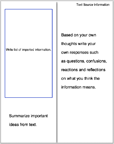 Double Entry note taking is basic strategy for taking notes from a text.
Double Entry note taking is basic strategy for taking notes from a text.
-
Embedded Questioning
This is a critical strategy every student must acquire in order to be come a thoughtful and critical reader. -
Find the Fake
 This strategy provides a game format as such that causes students to examine evidence and its accuracy.
This strategy provides a game format as such that causes students to examine evidence and its accuracy.
-
Fishbowl
The fishbowl is a format for facilitated group discussion that stimulates interest and encourages participation by focusing on a small group of people at a time, and by allowing the composition of that group to be fluid. -
Framed Character / Plot Chart
 This strategy provides an interesting way to deconstruct a text passage and then reconstruct it using a graphic organizer based on a character's motivation. In this example it is modified to include Result at the end.
This strategy provides an interesting way to deconstruct a text passage and then reconstruct it using a graphic organizer based on a character's motivation. In this example it is modified to include Result at the end.
-
Framed Paragraphs
 These strategy provides and guided structure on what to look for when reading a text passage.
These strategy provides and guided structure on what to look for when reading a text passage.
-
Get the GIST
 The word gist is defined as "the main or essential part of a matter." The GIST strategy (Cunningham, 1982) helps students read expository text and get the main idea. Students must then convey the gist of what they read in 20 words. The strategy is can be used with narrative text if students are asked to summarize after each chapter.
The word gist is defined as "the main or essential part of a matter." The GIST strategy (Cunningham, 1982) helps students read expository text and get the main idea. Students must then convey the gist of what they read in 20 words. The strategy is can be used with narrative text if students are asked to summarize after each chapter.
-
(HCDRS) Highlight, Chunk, Discuss, Research & Summarize
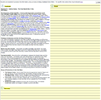 This reading electronic-based strategy developed by Gene Olbert (Alva, OK) targets a specific text passage using ALCA's webpage resource. Students may duplicate resource, highlight key evidence, chunk, discuss, and summarize while incorporating additional evidence from their textbook. The text passage would be a summary overview of key elements specific to a unit of study.
This reading electronic-based strategy developed by Gene Olbert (Alva, OK) targets a specific text passage using ALCA's webpage resource. Students may duplicate resource, highlight key evidence, chunk, discuss, and summarize while incorporating additional evidence from their textbook. The text passage would be a summary overview of key elements specific to a unit of study. -
History Frames
 Here is one of the strategies that we ought to be using in history and social studies classes because it lets us take advantage of a tool that students probably already possess ... namely, the story maps they've been using in English and Language Arts and Literature for years and years.
Here is one of the strategies that we ought to be using in history and social studies classes because it lets us take advantage of a tool that students probably already possess ... namely, the story maps they've been using in English and Language Arts and Literature for years and years. -
Jot-Charting
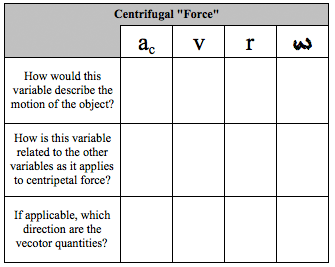 This strategy is an analytical approach by having students construct a matrix to jotting down key evidence from a passage.
This strategy is an analytical approach by having students construct a matrix to jotting down key evidence from a passage.
-
K W L
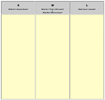 K-W-L, created by Donna Ogle, is a 3-column chart that helps capture the Before, During, and After components of reading a text selection.
K-W-L, created by Donna Ogle, is a 3-column chart that helps capture the Before, During, and After components of reading a text selection.
-
Literacy and Writing Strategies for the Social Studies.docx
This file provides a variety of strategies for mind mapping of historical content, Power Thinking, One Sentence Summary Frames, among many other Social Studies strategies. -
Object(ive) Writing
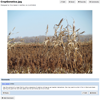 This creative writing activity focuses on a specific object, place, event, or artificat of some kind. Writing is posted in a public location (e.g., in classroom, blog) for classmates to view and build on.
This creative writing activity focuses on a specific object, place, event, or artificat of some kind. Writing is posted in a public location (e.g., in classroom, blog) for classmates to view and build on.
-
One Sentence Summary Frame
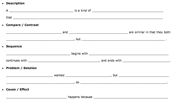 This strategy is a concise approach to target specific verbs using s simle sentence.
This strategy is a concise approach to target specific verbs using s simle sentence.
-
Pause-Think-Retell
This basic strategy incorporates reading, recall, and discussion to reinforce understanding a text passage. -
PLAN (Modified)
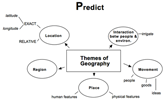 This Predict-Locate-Add-Note strategy is a visual method to capture information from a text passage using a mind map.
This Predict-Locate-Add-Note strategy is a visual method to capture information from a text passage using a mind map.
-
Power Thinking
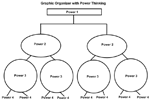 Power Thinking is an alternative system for outlining information that is hierarchical in nature. In other words, the information can be grouped according to main ideas, subtopics, and details. It considers information according to which level it belongs on, and we use numbers to signify those levels.
Power Thinking is an alternative system for outlining information that is hierarchical in nature. In other words, the information can be grouped according to main ideas, subtopics, and details. It considers information according to which level it belongs on, and we use numbers to signify those levels.
-
Problem-Solution Chart
 This strategy is a graphic organizer that focuses on components of critical thinking. It is a readily understandable layout for students to utilize.
This strategy is a graphic organizer that focuses on components of critical thinking. It is a readily understandable layout for students to utilize.
Source: http://www.readingquest.org/strat/problem.html
-
Pyramids
 This strategy is used to record and organize information using main headings, sub headings, and supporting details. It helps students to better comprehend a reading selection.
This strategy is used to record and organize information using main headings, sub headings, and supporting details. It helps students to better comprehend a reading selection.
-
Questioning the Author a Critical Thinking Approach
 This modified verions of Questioning the Author by McKeown, Beck, & Worthy (1993) utilizes the Critical Thinking Standards in order to analyze an author's statements.
This modified verions of Questioning the Author by McKeown, Beck, & Worthy (1993) utilizes the Critical Thinking Standards in order to analyze an author's statements. -
Radio Reading
This reading strategy has a strong discussion component that helps the reader apply what was read.
. -
Reading Level Guide
 This strategy requires the students to determine literal meaning, interprete, and applied understanding of a text selection.
This strategy requires the students to determine literal meaning, interprete, and applied understanding of a text selection. -
Semantic Feature Analysis
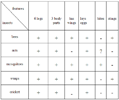 Semantic features analysis strategy has students to identify and use key words and major concepts of the text.
Semantic features analysis strategy has students to identify and use key words and major concepts of the text.
-
SQ3R Chart
 The SQ3R strategy is a widely used strategy that helps students have high levels of comprehension of a selected text.
The SQ3R strategy is a widely used strategy that helps students have high levels of comprehension of a selected text.
-
Story Board (Draft)
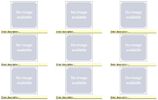 This strategy incorporates a sequential documentations using images and written captions. It may be used to document a chain of events or the sequence in a process.
This strategy incorporates a sequential documentations using images and written captions. It may be used to document a chain of events or the sequence in a process.
-
Strategy Alignment Instrument
This strategy contains a possible checklist resource using TLE, CCSS, and the Rigor/Relevance Framework to create a matrix that can be used by teachers to differentiate literacy strategies. One may use the access key to copy and update to include different strategies. -
Strategy Log (E Lima)
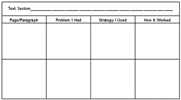 This simple note-taking tool is designed to help students to identify the reading strategies they use and their usefullness in helping comprehension. It allows one to do self-assessment for their own facility with multiple reading strategies.
This simple note-taking tool is designed to help students to identify the reading strategies they use and their usefullness in helping comprehension. It allows one to do self-assessment for their own facility with multiple reading strategies.
-
Target Questions & Writing a Tweet
This writing activity models Tweeting with a focus on daily target questions.
-
Text Coding
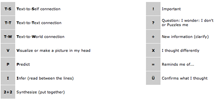 Text coding is a very useful tool to help students moniter their comprehension of reading a text.
Text coding is a very useful tool to help students moniter their comprehension of reading a text.
-
The Meaning Of
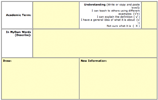 This strategy focuses on helping a student develop a working understanding of academic vocabulary.
This strategy focuses on helping a student develop a working understanding of academic vocabulary.
-
Think-Pair-Share
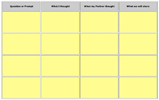 Think-Pair-Share is a strategy designed to provide students with think time and share time. It is a learning strategy developed by Lyman and associates to encourage student classroom participation. Think-Pair-Share encourages a high degree of pupil response and can help keep students on task.
Think-Pair-Share is a strategy designed to provide students with think time and share time. It is a learning strategy developed by Lyman and associates to encourage student classroom participation. Think-Pair-Share encourages a high degree of pupil response and can help keep students on task.
-
Venn Diagrams
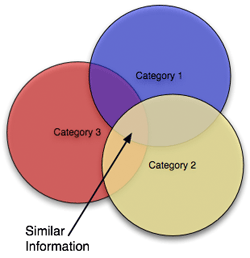 This graphic organizer provides a frame work useful for making comparisons of two or more texts.
This graphic organizer provides a frame work useful for making comparisons of two or more texts.
Comments
Be the first to comment below.